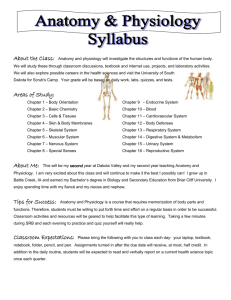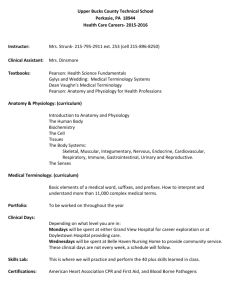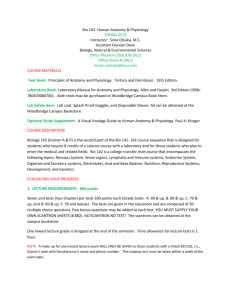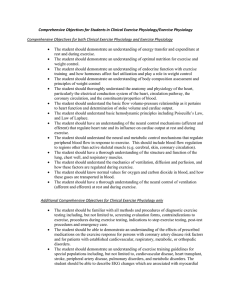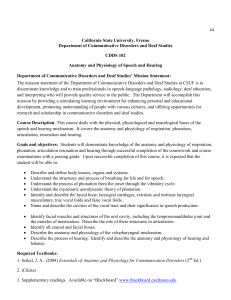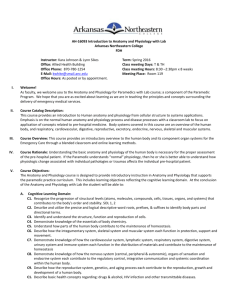anatomy & physiology ii lab
advertisement
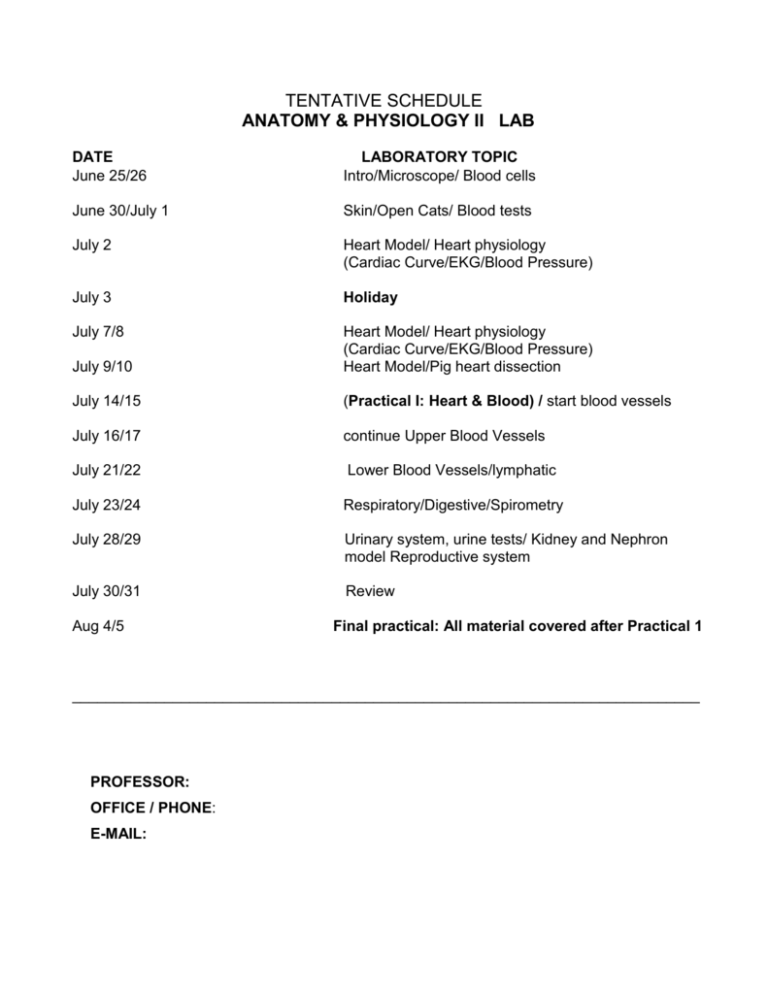
TENTATIVE SCHEDULE ANATOMY & PHYSIOLOGY II LAB DATE June 25/26 LABORATORY TOPIC Intro/Microscope/ Blood cells June 30/July 1 Skin/Open Cats/ Blood tests July 2 Heart Model/ Heart physiology (Cardiac Curve/EKG/Blood Pressure) July 3 Holiday July 7/8 July 9/10 Heart Model/ Heart physiology (Cardiac Curve/EKG/Blood Pressure) Heart Model/Pig heart dissection July 14/15 (Practical I: Heart & Blood) / start blood vessels July 16/17 continue Upper Blood Vessels July 21/22 Lower Blood Vessels/lymphatic July 23/24 Respiratory/Digestive/Spirometry July 28/29 Urinary system, urine tests/ Kidney and Nephron model Reproductive system July 30/31 Review Aug 4/5 Final practical: All material covered after Practical 1 ___________________________________________________________________________ PROFESSOR: OFFICE / PHONE: E-MAIL: TEXTS: Human Anatomy & Physiology Laboratory Manual, cat version, 2nd custom ed. For Indian River State College **optional: The A & P Coloring Book by Marieb The Visual Dictionary of the Human Body (ISBN: 1-879431-18-1) Pictorial Anatomy of the Cat by Gilbert SUPPLIES: A shared dissecting kit is supplied by the college, additional supplies to be provided by student. The student is responsible for providing his/her own gloves, goggles, mask, lab coat and Vick VapoRub for dissections, if desired. TESTS: 2 lab practical’s: Test 1 (100 points) &Test 2 (200 points) (300 points total) 2 lab reports (EKG and Urinalysis) (100 points total) GRADES: Final grades are determined based on the percent of 400 points earned No extra credit projects will be granted beyond the test assignments. Grades are assigned on the following basis: A - 90% - 100% D - 60% - 69% B - 80% - 89% F - below 60% C - 70% - 79% W = withdraw by published college deadline (Monday, July 22, 2014) I = an incomplete may be given to passing students only in EXTREME cases PROPER ATTIRE: Proper dress is required for your protection. In keeping with Federal Regulations, students are required to wear closed toe shoes in laboratory. The attire worn in the laboratory work setting should include full coverage of legs and upper arms, hair restraints for long hair, no dangling jewelry, and no low cut shirts or blouses. **Optional: lab coat or apron to protect clothing ATTENDANCE: Students are expected to be present in lab in order to accomplish the learning goals for the lab practical examinations. To effectively utilize lab time, preparation is required on the part of the student. The student should have read the assigned laboratory exercises and attached handouts to become familiarized with details for lab practical’s BEFORE laboratory starts. (NOTE: The above schedule is only tentative and each student is responsible for knowing exact assignments and test arrangements.) MAKE-UP POLICY: Students must take their lab practical with their lab section. If a student is unable to attend that practical session, he/she MUST obtain his/her instructor=s permission ASAP to take the practical the day of the final, no makeups with other sections. CHEATING: Cheating of ANY kind WILL NOT be tolerated by this Department. Anyone caught cheating will automatically receive an F for the semester (No withdraws allowed for cheaters). Anyone who witnesses this inexcusable behavior and does not report it is considered guilty of improper conduct. LEARNING OUTCOMES: Investigate the structure and functioning of the endocrine, cardiovascular, lymphatic, respiratory, digestive, urinary, and reproductive systems and relate them to the laboratory experience Apply problem solving, analytical, and communication skills based on the scientific method that will provide the foundation for lifelong learning and career development by explaining the importance of each aspect in the maintenance of homeostasis in the human body and investigating the counterpart of normal function as leading to particular pathological problems. Make use of technology to organize, acquire, and convey information relevant to the biological sciences.



